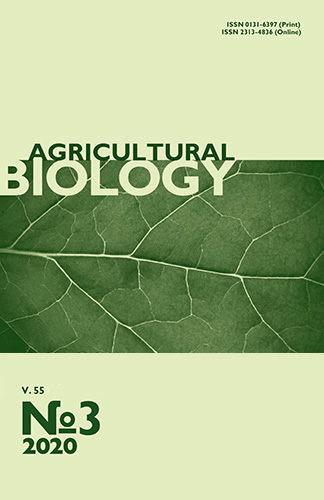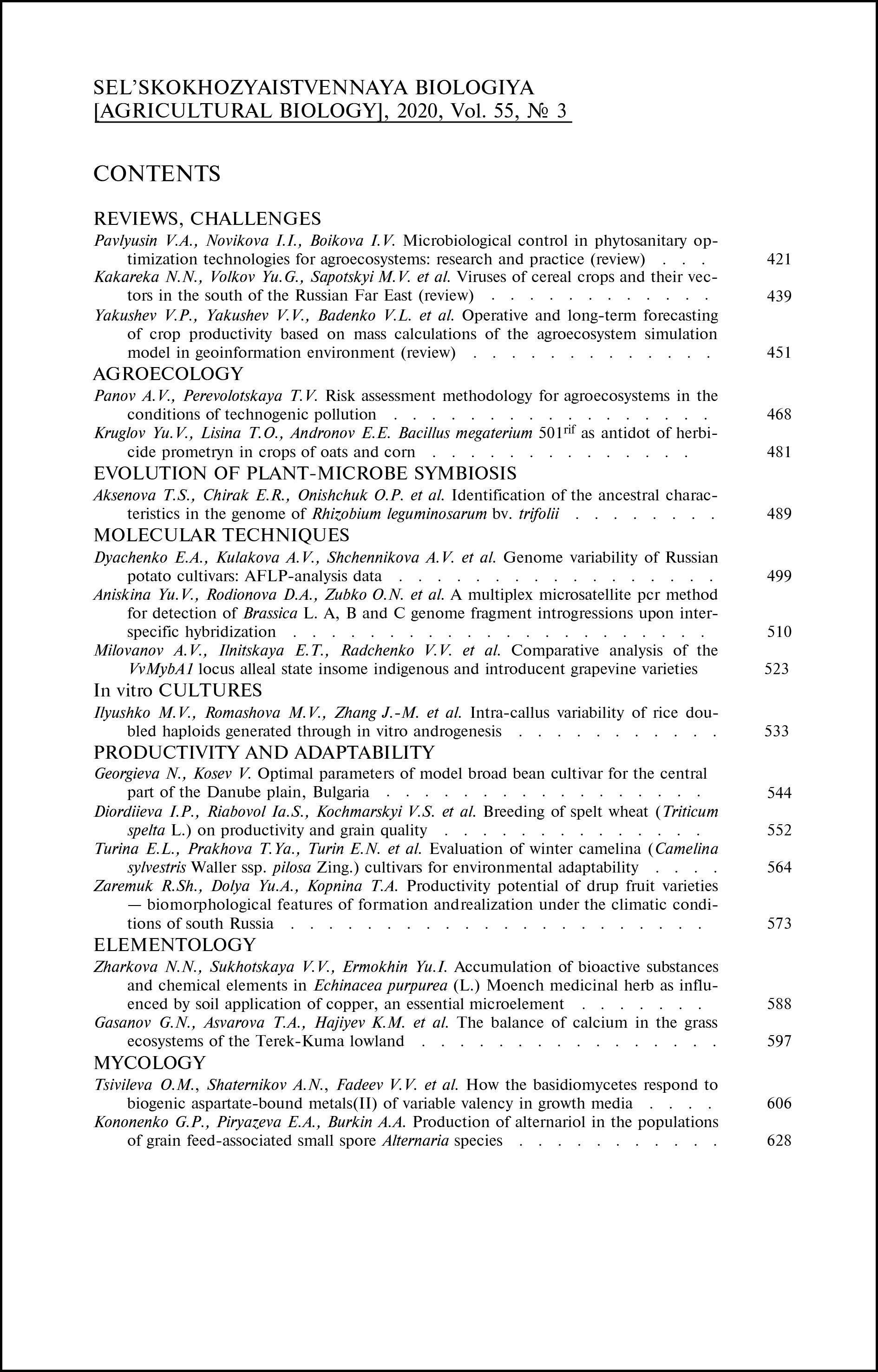doi: 10.15389/agrobiology.2020.3.573eng
UDC: 634.2:581.1:631.55(470.62)
Acknowledgements:
The research was done using the equipment of the Center for Collective Use (CKP) “Genetic Collection of Fruit Crops” of the North-Caucasian Federal Scientific Center of Horticulture, Viticulture, Winemaking (Krasnodar).
PRODUCTIVITY POTENTIAL OF DRUP FRUIT VARIETIES — BIOMORPHOLOGICAL FEATURES OF FORMATION AND REALIZATION UNDER THE CLIMATIC CONDITIONS OF SOUTH RUSSIA
R.Sh. Zaremuk, Yu.A. Dolya, T.A. Kopnina
North-Caucasian Federal Scientific Center of Horticulture, Viticulture, Winemaking, 39, ul. im. 40-letiya Pobedy, Krasnodar, 350901 Russia, e-mail zaremuk_rimma@mail.ru (✉ corresponding author), skzniisiv2015@mail.ru, tatjanakopnina@rambler.ru
ORCID:
Zaremuk R.Sh. orcid.org/0000-0003-0298-0914
Kopnina T.A. orcid.org/0000-0003-3456-1597
Dolya Yu.A. orcid.org/0000-0002-1623-1511
Received October 19, 2019
Productivity, the main characteristic of a variety of fruit crops, which is due to a set of elements, determines the resistance of a crop to environmental stress factors and its suitability for industrial growing conditions. The impact of climatic stresses annually results in only 30-40% realization of productivity potential of fruit plants. In fruit plants, including sweet and ordinary cherries, fruit-bud differentiation takes a long time. In the conditions of the southern Russia (Prikubanskaya gardening zone of the Krasnodar Territory), it begins in July of the current year and ends in April-May of the next year. The climate in the Krasnodar Territory is quite mild, generally favorable for the cultivation of sweet and ordinary cherries. Nevertheless, even in the south of Russia, there is a high risk of annual abiotic stresses, negatively affecting fruit plants and impeding realization of their productivity potential. In the present work, a comprehensive biomorphological study was first undertaken to assess the regional productivity potential of sweet and ordinary cherries of various ecological and geographical origins. Our research aimed to establish the regional patterns of productivity element formation during morpho- and organogenesis in Prunus L. species and hybrids, to identify the most vulnerable stages in plant annual development cycles, and to distinguish the varieties with high and sustainable yielding under risky weather conditions. Three introduced Cerasus avium (L.) Moench varieties of different ecogeographic origins (Valerii Chkalov, Melitopolskaya Chernaya, and Polyanka), six domestic C. avium varieties (Kavkazskaya, Sashen’ka, Volshebnitsa, Dar izobiliya, Alaya, and Mak), four introduced C. vulgaris Mill. varieties (Kelleris, Nefris, Fanal, and Erdi Botermo), and seven interspecific hybrids C. vulgaris × C. avium (Kirina, Dombaziya, Duk Ivanovna, Duk Khodosa, Igrushka, and Shalun’ya) were studied during 2006-2019, Experimental Production Center of the North-Caucasian Federal Scientific Center of Horticulture, Viticulture, Winemaking, Krasnodar; 6×4, 7×3, and 5×3 m plant spacing). Cerasus mahaleb (L.) Mill. And Cerasus avium L. plants were rootstock plants, all experiments were arranged in three replications. Phenology of all stages and sub-stages of the annual (vegetative and generative) plant growth was described as per BBCH system (Biologische Bundesanstalt, Bundessortenamt and Chemische Industrie, Germany). Morphogenesis of yield components was investigated in 15 generative buds 2 times in December and February, weekly in March-April, and weekly in July-November by light microscopy (Olympus ВХ41, Olympus Corporation, Japan). In spring, flowers, ovaries, and fruits were gradually counted on third-order skeletal branches, and the degree of their reduction were calculated to estimate biological productivity. The number of fruit buds and growth buds was estimated 2 times a week in August and September. To assess the winter hardiness, 90 vegetative buds and 180 fruit buds from different sides of the lower and upper branches of 3 trees of the same variety were collected in 3 replicates. It was found that the reduction of productivity elements in the stressful conditions of southern gardening occurs annually at the same (critical) stages of development of fruit plants. These stages are i) reproductive organ initiation; ii) archesporium formation in anthers; iii) pollen mother cells, iv) mono- and binuclear pollen grains, and v) macrosporogenesis. The critical periods of yield formation in the conditions of the Krasnodar Territory are II-III decades of March, and I-II decades of April, May and July, when special agrotechnology should be applied to reduce the impact of stress and to increase yields. A direct correlation was revealed between temperature and air humidity during each critical period, the fruiting coefficient and the final yield (r = +0,97, р < 0,001). In our tests, the following samples are characterized by high fruiting rates and sustainable yields: domestic cherry varieties Kavkazskaya (62 % and 31.3 t/ha, respectively), Alaya (46 % and 30.0 t/ha), Sashen’ka (45 % and 26.6 t/ha), and Volshebnitsa (42 % and 23.3 t/ha), interspecific hybrids Duk Khodosa (46 % and 23.3 t/ha), Kirina (44 % and 23.3 t/ha), and Duk Ivanovna (44 % and 20.0 t/ha), and an ordinary cherry variety Kelleris (45 % and 20.0 t/ha). These varieties and hybrids can be cultivated in commercial orchards and used as genetic donors in breeding for sustainable productivity.
Keywords: drup fruit, sweet cherry, ordinary cherry, varieties, abiotic factors, adaptive potential, biological productivity, generative development, organogenesis, yielding.
REFERENCES
- Bondarenko L.V., Maslova O.V., Belkina A. V., Sukhareva K.V. Vestnik Rossiiskogo ekonomicheskogo universiteta im. G.V. Plekhanova, 2018, 2(98): 84-93 CrossRef (in Russ.).
- Campoy J., Ruiz D., Egea J. Dormancy in temperate fruit trees in a global warming context: a review. Scientia Horticulturae, 2011, 130(2): 357-372 CrossRef
- Luedeling E. Climate change impacts on winter chill for temperate fruit and nut production: a review. Scientia Horticulturae, 2012, 144: 218-229 CrossRef
- Else M., Atkinson C. Climate change impacts on UK top and soft fruit production Outlook on Agriculture, 2010, 39: 257-262 CrossRef
- Alekhina E.M., Dolya Yu.A. Plodovodstvo i vinogradarstvo Yuga Rossii, 2013, 24(06): 10-17 (in Russ.).
- Dolya Yu.A. Formirovanie produktivnosti sortov chereshni v usloviyakh Severnogo Kavkaza. Kandidatskaya dissertatsiya [The formation of sweet cherry productivity in the North Caucasus. PhD Thesis]. Krasnodar, 2011 (in Russ.).
- Chumakov S.S. Vozmozhnosti realizatsii biologicheskogo potentsiala plodovykh rastenii v raznovozrastnykh nasazhdeniyakh yuga Rossii [Possibilities for realizing the biological potential of fruiting plants in different-aged stands of Southern Russia]. Krasnodar, 2011 (in Russ.).
- Eremina O.V. V sbornike: Metody i reglamenty optimizatsii strukturnykh elementov agrotsenozov i upravleniya realizatsiei produktsionnogo potentsiala rastenii [In: Methods and regulations to optimize structural elements of agrocenoses and to manage realization of plants production potential]. Krasnodar, 2009: 185-189 (in Russ.).
- Ozherel'eva Z.E., Gulyaeva A.A. Sovremennoe sadovodstvo, 2015, 3(15): 45-51 (in Russ.).
- BuntsevichL.L. Morfofiziologicheskie osobennosti formirovaniya urozhainosti yabloni domashnei (Malus domestica Borkh.): monografiya [Morphophysiological features of domestic apple try (Malus domestica Borkh.) yield formation: a monograph]. Krasnodar, 2012 (in Russ.).
- Zhuchenko A.A. Adaptivnoe rastenievodstvo: ekologo-geneticheskie osnovy [Adaptive crop production: ecological and genetic aspects]. Kishinev, 1990 (in Russ.).
- Doroshenko T.N., Klad' A.A., GegechkoriB.S. Opredelenie produktivnosti plodovykh rastenii i priemy ee regulirovaniya [Determination of fruit plant productivity and methods of its regulation]. Krasnodar, 1999 (in Russ.).
- Dragavtsev V.A., Dragavtseva I.A., Mozhar N.V., Morenets A.S. Trudy Kubanskogo gosudarstvennogo agrarnogo universiteta, 2018, 72: 142-148 CrossRef (in Russ.).
- Spitsyn I.P. Tsitoembriologicheskie, geneticheskie i ekologicheskie aspekty produktivnosti vishni. Avtoreferat doktorskoi dissertatsii [Cytoembryological, genetic and environmental aspects of cherry productivity. DSc Thesis]. Michurinsk, 2003 (in Russ.).
- Taranov A.A. Plodovodstvo, 2005, 17(1): 63-67 (in Russ.).
- Buntsevich L.L., Kostyuk M.A., Paletskaya E.N. Plodovodstvo i yagodovodstvo Rossii, 2013, 31(1): 55-61 (in Russ.).
- Egorov E.A., Il'ina I.A., Prichko T.G., Dragavtseva I.A., Popova V.P., Alekhina E.M., Alferov V.A., Artyukh S.N., Khvostova I.V., Yakuba G.V., Cherkezova S.R., Podgornaya M.E., Smolyakova V.M., Efimova I.L., Ul'yanovskaya E.V., Shafrostova N.K., Zaremuk R.Sh., Sergeev Yu.I., Lugovskoi A.P., Teren'ko G.N., Kuznetsova A.P., Bogatyreva S.V., Mozhar N.V., Govorushchenko S.V., Tyshchenko E.L., Shadrina Zh.A. Adaptivnyi potentsial sadovykh kul'tur yuga Rossii v usloviyakh stressovykh temperatur zimnego perioda (metodicheskie rekomendatsii) [Adaptive potential of garden crops in Southern Russia under stressful temperatures of the winter period (methodical recommendations)].Krasnodar, 2006 (in Russ.).
- Salazar-Gutiérrez M.R., Chaves B., Anothai J., Whiting M., Hoogenboom G. Variation in cold hardiness of sweet cherry flower buds through different phenological stages. Scientia Horticulturae, 2014, 172: 161-167 CrossRef
- Hedhly A. Hormaza J.I., Herrero M. Warm temperatures at bloom reduce fruit set in sweet cherry. Journal of Applied Botany and Food Quality, 2007, 81(2): 158-164.
- Zhang L., Ampatzidis Y., Whiting M.D. Sweet cherry floral organ size varies with genotype and temperature. Scientia Horticulturae, 2015, 182: 156-164 CrossRef
- Woznicki T.L., Heide O.M., Sønsteby A., Måge F., Remberg S.F. Climate warming enhances flower formation, earliness of blooming and fruit size in plum (Prunus domestica L.) in the cool Nordic environment. Scientia Horticulturae, 2019, 257: 108750 CrossRef
- Rodrigo J., Herrero M. Effects of pre-blossom temperatures on flower development and fruit set in apricot. Scientia Horticulturae, 2002, 92(2): 125-135 CrossRef
- Götz K.-P., Chmielewski F.-M., Homann T., Huschek G., Matzneller P., Rawel H.M. Seasonal changes of physiological parameters in sweet cherry (Prunus avium L.) buds. Scientia Horticulturae, 2014, 172: 183-190 CrossRef
- Vitkovskii V.L. Morfogenez plodovykh rastenii [Fruit plant morphogenesis]. Leningrad, 1984 (in Russ.).
- Zhang L., Ferguson L., Whiting M.D. Temperature effects on pistil viability and fruit set in sweet cherry. Scientia Horticulturae, 2018, 241: 8-17 CrossRef
- Kolomiets I.A. Preodolenie periodichnosti plodonosheniya yabloni [Overcoming the periodicity of fruiting apple trees]. Kiev, 1961 (in Russ.).
- Sergeeva N.N., Buntsevich L.L. Morphogenetic features of development and the feed regime of an apple-tree in the conditions of south of Russia. Sel'skokhozyaistvennaya biologiya [Agricultural Biology], 2010, 5: 92-97 (in Russ.).
- Hedhly A., Hormaza J.I., Herrero M. Effect of temperature on Pollen Tube Kinetics and Dynamics in sweet cherry, Prunus avium (Rosaceae). American Journal of Botany, 2004, 91(4): 558-564 CrossRef.
- Dragavtseva I.A. Razvitie tsvetkovykh pochek alychi v svyazi s zimostoikost'yu ee sortov v usloviyakh Kryma. Avtoreferat kandidatskoi dissertatsii [Development of cherry plum flower buds in connection with the winter hardiness of varieties in Crimea. PhD Thesis]. Odessa, 1966 (in Russ.).
- Sanzol J., Herrero M. The "effective pollination period" in fruit trees. Scientia Horticulturae,2001, 90(1-2): 1-17 CrossRef
- Nen'ko N.I., Kiseleva G.K. V knige: Sovremennye metodologiya, instrumentarii otsenki i otbora selektsionnogo materiala sadovykh kul'tur i vinograda [In: Modern methodology, tools for assessing and selecting breeding material for garden crops and grapes]. Krasnodar, 2017: 66-78 (in Russ.).
- Koutinas N., Pepelyankov G., Lichev V. Flower induction and flower bud development in apple and sweet cherry. Biotechnology and Biotechnological Equipment, 2010, 24(1): 1549-1558 CrossRef
- Rabadanova K.K., Tyutereva E.V., Matskevich V.S., Deminchik V.V., Voitsekhovskaya O.V. Cellular and molecular mechanisms controlling autophagy: a perspective to improve plant stress resistance and crop productivity (review). Sel'skokhozyaistvennaya biologiya [Agricultural Biology], 2018, 53(5): 881-896 CrossRef
- Fadón E., Herrero M., Rodrigo J. Flower development in sweet cherry framed in the BBCH scale. Scientia Horticulturae, 2015, 192: 141-147 CrossRef
- Dzhigadlo E.N., Kolesnikova A.F., Eremin G.V., Morozova T.V., Kan'shina M.V. V knige: Programma i metodika sortoizucheniya plodovykh, yagodnykh i orekhoplodnykh kul'tur /Pod redaktsiei E.N Sedova, T.P. Ogol'tsovoi [In: The program and methodology to study fruit, berry and nut-bearing crop varieties. E.N Sedov, T.P. Ogol'tsova (eds.)]. Orel, 1999: 300-350 (in Russ.).
- Dzhigadlo E.N., Shchekotova L.A., Turovtsev N.I., Morozova T.V., Eremin G.V. V knige: Programma i metodika selektsii plodovykh, yagodnykh i orekhoplodnykh kul'tur /Pod redaktsiei E.N. Sedova [The program and method for fruit, berry and nut-bearing crop breeding. E.N. Sedov (ed.)]. Orel, 1995: 234-313 (in Russ.).
- Isaeva I.S. Morfofiziologiya plodovykh rastenii. Kurs lektsii /Pod redaktsiei F.M. Kuperman [Morphophysiology of fruit plants. Lecture course. F.M. Kuperman (ed.)]. Moscow, 1974 (in Russ.).
- Kiseleva G.K. V knige: Sovremennye metodologiya, instrumentarii otsenki i otbora selektsionnogo materiala sadovykh kul'tur i vinograda [Modern methodology, tools for assessing and selecting breeding material for garden crops and grapes]. Krasnodar, 2017: 51-60 (in Russ.).












